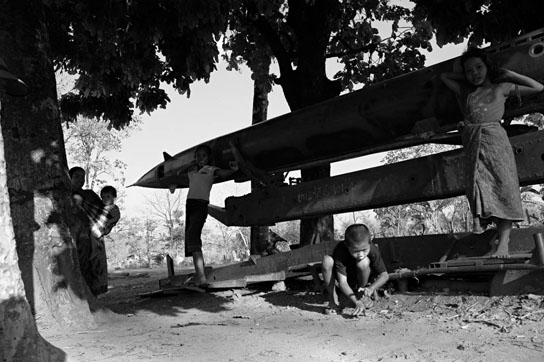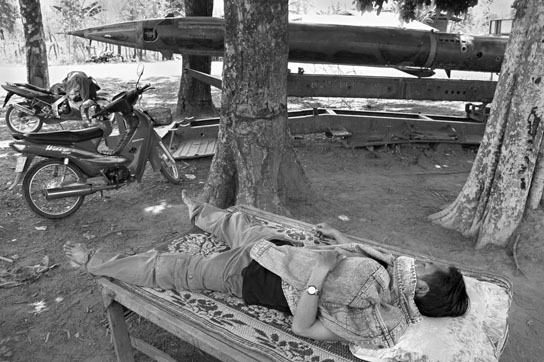(This is another post that comes from my invitation to all of you to send me two of your pictures to get my thoughts on them. Send two photos at 544 pixels/72 dpi to me at: tekamah at me dot com Explain something about yourself, the photos and what you'd like for me to address about them.)
Asia and New Mexico-based photographer Jerry Redfern writes from Laos, where, among other ventures, he and his wife are working on a book-length project about Laotians living among bombs left from the Vietnam War. As he says, more than 300 people a year are still injured or killed by unexploded bombs.
The two pictures he sent show Soviet-made anti-aircraft missiles that the Vietnamese stripped of fuel and explosives and left in Pa’am, a tiny village on the Ho Chi Minh Trail, rather than take them back to Vietnam after the war.

 Both photos © Jerry Redfern
Both photos © Jerry Redfern
Jerry writes of the missiles, “It is one of the very few remaining remnants of why the US bombed Laos. I got a couple of photos of the thing, and have never been able to choose which I like better - the (more artistically plain) guy taking a noontime siesta next to a missile, or the (more dark and arty) kids playing in its shadow.”
It is a tough call. Both are interesting and well made. Each conveys a sense of life going on with these odd gizmos. The second photo, of the man napping is more successful as an image but appears to have fewer elements to spend time with than the other image – read further for more thoughts on this. The first image is a little hard to read in the resolution I have but I’m assuming it’s possible to pull detail in the shadows. Its flaw is that it fells a bit too tight, as if the composition is to just get the people into the frame and nothing more. That creates pinch points at the girl’s elbow on the right and with the trees on the left.
I first heard of pinch points during painting composition class. The notion is that the mind and eye need to travel freely through or be stopped completely at the edges of a composition. The girl’s elbow creates a tension point that doesn’t fully stop travel through the frame, nor does it allow passage. The same is true to a lesser extent in the second photo, the point below the sleeping man and the left side of the scooters.
In publishing environments, copy editors who put together inside pages often crop photos to the edge of whatever the dominant element of the frame is, essentially making the photos fit the frame in the same way they make a story fit the space available. Inevitably the crops create these uncomfortable-feeling, literal, bland photos out of what may have been interesting ones. So I also call this type of composition the copy editor crop.
These two photos are hardly that extreme. But if these two pictures do reflect a tendency to compose this way, I’d suggest that you loosen a bit or tighten a bit, in general. Just a tweak, not huge.
There’s another aspect to consider to these photos. Although there are more people and more activities in the first photo, in some ways the second one is more complex. I was reminded of how small things in a photo can say big things during a talk by Photographer Shawn Records at the Portland Art Museum yesterday. In the second photo, the man’s watch the fact he has no shoes on, the types and quality of scooters, the type of jean jacket, his haircut, how worn the dirt is all say something about this time and place that is unique to the moment.
And if we can say of a photograph, this is unique, then we’ve reached a pinnacle.
